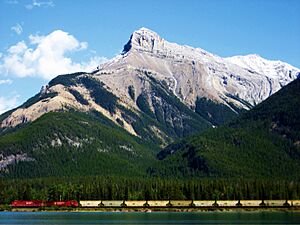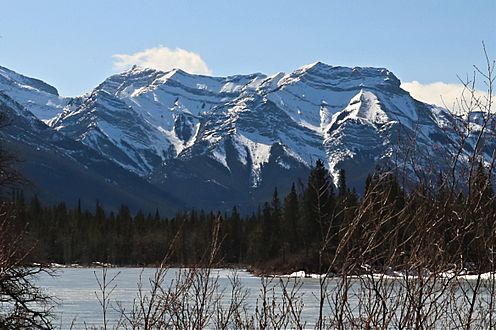Mount McGillivray facts for kids
Quick facts for kids Mount McGillivray |
|
|---|---|

Mount McGillivray
|
|
| Highest point | |
| Elevation | 2,451 m (8,041 ft) |
| Prominence | 211 m (692 ft) |
| Parent peak | Skogan Peak (2662 m) |
| Listing | Mountains of Alberta |
| Geography | |
| Location | Alberta, Canada |
| Parent range | Canadian Rockies |
| Topo map | NTS 82O/03 |
| Geology | |
| Age of rock | Cambrian |
| Type of rock | Limestone |
| Climbing | |
| Easiest route | Scramble |
Mount McGillivray is a mountain in the Canadian Rockies of Alberta, Canada. It stands about 2,451 meters (8,041 feet) tall. Its closest taller neighbor is Skogan Peak, about 3 kilometers (1.9 miles) away. You can easily spot Mount McGillivray from Highway 1, also known as the Trans-Canada Highway, near Exshaw.
Contents
History of Mount McGillivray
Mount McGillivray is named after Duncan McGillivray (1770-1808). He was one of the first European explorers, along with David Thompson, to see the Bow Valley. In 1800, McGillivray and Thompson traveled from Rocky Mountain House. They explored west into the Bow Valley, reaching the area of Mount McGillivray. They were looking for the start of the Columbia River.
The mountain's name became official in 1957. This was decided by the Geographical Names Board of Canada.
Cold War Tunnels
During the Cold War, tunnels and vaults were built under the north side of the mountain. This was part of a plan to safely store important government documents. However, the project was never finished.
Geology of the Mountain
Mount McGillivray is made of sedimentary rock. This type of rock formed from layers of sand, mud, and shells over millions of years. These layers were laid down during the Precambrian to Jurassic periods.
The rock formed in shallow seas. Later, during a time called the Laramide orogeny, these rock layers were pushed up and over younger rock. This process created the mountains we see today.
Climate Around Mount McGillivray
Mount McGillivray is in a subarctic climate zone. This means it has cold, snowy winters and mild summers. Temperatures can drop below −20 °C (−4 °F). With wind, it can feel even colder, below −30 °C (−22 °F).
Rain and melted snow from Mount McGillivray flow into the Bow River. The Bow River is a branch of the Saskatchewan River.
Gallery







